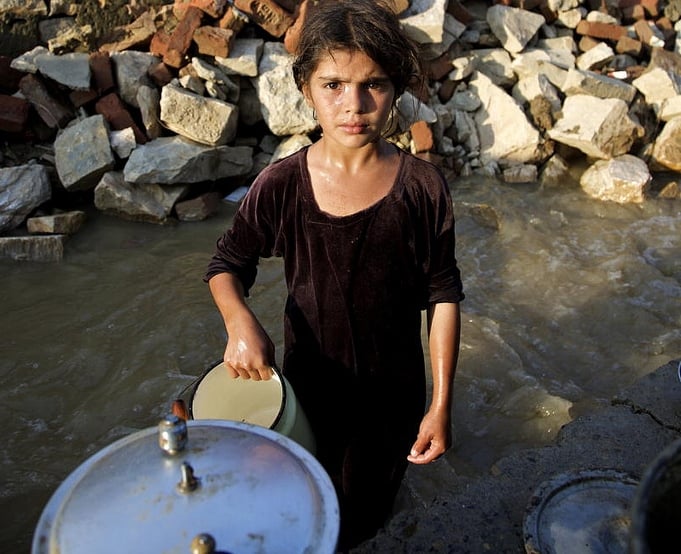The waters flow crystal clear across north Pakistan’s mountainous province of Gilgit-Baltistan but the reality is quite different from that picture of pristine beauty — 78% of the water tested from towns in the province fall in the categories of low to very high risk for human health and only 22% comply with WHO standards.
This was revealed in a recent report by the Gilgit-Baltistan Environmental Protection Agency (GB-EPA), which also states that contamination levels may double in the summer because people graze animals in the catchment areas from where waters are directly used for drinking. The absence of effective sewage systems and effluent treatment plants means that the waste empties directly into surface water bodies from where drinking water is sourced.
Glaciers and snow are the principal water source in Gilgit-Baltistan, located in the extreme north of the country, home to some of world’s highest mountain ranges and to three of the world’s largest glaciers, Biafo, Baltoro and Batura. The province, which has a population of two million, is also the place from where the country sources much of its water through its lifeline, the Indus River.
The melted water from snow fields and glaciers enters streams, which feed manmade channels that take water to settlements for agriculture, livestock and domestic requirements, including drinking.
But only 80% of Pakistan’s urban population and 11% of the rural have access to piped water. According to the report, which covered seven major urban centres in the province, the situation in Gilgit-Baltistan is worse, with only 40% of people having access to piped water in urban areas – but in reality it might be less than half of this. The observations indicate that many of the systems are either completely out of order or need some sort of repair.
To compound the situation, the lack of proper drinking water treatment plants has also led to water contamination and consequently, environmental and health problems arising from water-borne infections. The document goes on to add that almost all drinking water systems are contaminated with organic and inorganic pollutants.
The water supply systems in the urban centres of Gilgit-Baltistan are primarily based on the use of surface waters. This means that people face moderate to acute water scarcity during the winter months when glacier melt is reduced. The use of ground water is uncommon, except for a few riverside villages in Skardu, for instance, where people draw water from shallow wells.
Pollution contaminates the Indus
The main sources of water pollution in Gilgit-Baltistan are domestic and commercial waste, particularly from the urban settlements. Other than hotels and restaurants, there is no industry in the region.
“Urban settlements lack liquid and solid waste disposal systems, hence surface and ground water bodies are under threat of faecal and chemical pollution due to household and agriculture run-off,” GB-EPA chief Shehzad Shigri told the thethirdpole.net. Most of this waste is emptied into small water streams or directly into the Indus River itself.
In Gilgit town, for instance, the most populated urban centre and capital of the province, at least 10 major drains empty into the main Indus River. Waste from homes and hotels also enter the river directly without passing through any treatment plant, he said.
To compound the horror, water pumps lift the water from the river for several localities, including the university. A significant chunk of the 150,000 population is getting water that is untreated and full of contaminants.
The contaminants include municipal waste as well as hospital and slaughterhouse waste. Many people also collect water directly from the river, streams and springs polluted with the mixture of dust and other organic particles. According to the report, the turbidity in water is caused by the presence of suspended matter, such as clay, silt, colloidal organic particles, plankton and other microscopic organisms.
According to Dr Qaim Ali Khan, who practices in the area, the incidence of water-borne diseases is the highest in Gilgit town. These include diarrhoea and cholera as well as a skin infections and kidney diseases. The situation is similar in Skardu and other urban areas. “Such waters present serious dangers to the human health,” Khan told thethirdpole.net.
Environmentalist Hamid Marwat, who worked for IUCN and lived in the area, said almost 100% percent of the drinking water was contaminated and dangerous for health. “During the two years of my service in Gilgit, I used water for drinking only twice without boiling and fell ill on both occasions.”
Unfortunately, this is true not just of Gilgit-Baltistan but also other mountain areas like Swat, the Bisham valley of Khyber Pakhtunkhwa and the hill town of Murree. Elaborating on the problem in Murree, he said all the waste, particularly from the poultry industry, falls into the Rawal dam, the only source of drinking water to Islamabad’s twin town Rawalpindi, which has a population of three million.
Three years ago, the Supreme Court had taken suo motu action on the issue but no effective steps have been taken and people continue to use contaminated water drinking and cooking.
The GB-EPA study recommended that it “is imperative to design and implement sanitary inspection to reduce likelihood of contamination in catchment areas of water supply works and system components”.
“All drinking water sources should be protected and tapped as per international standards and water delivery systems should be chlorinated as per the WHO recommendations, especially in the summer seasons,” it said.
